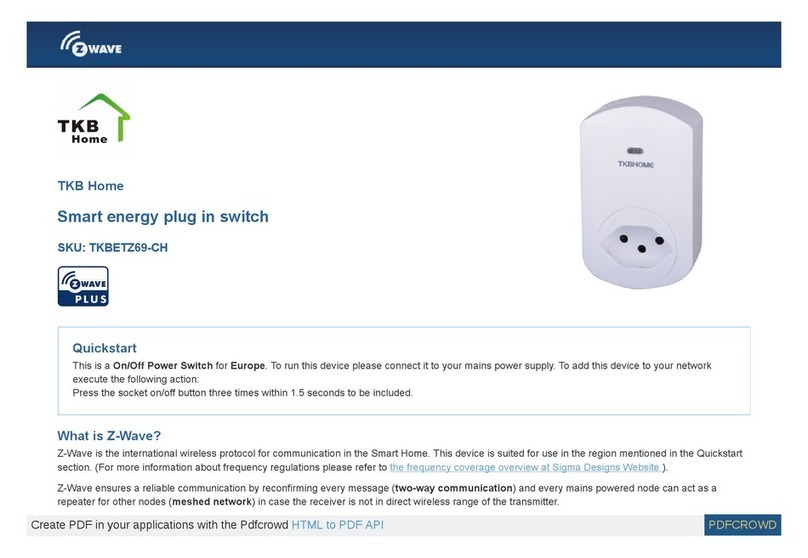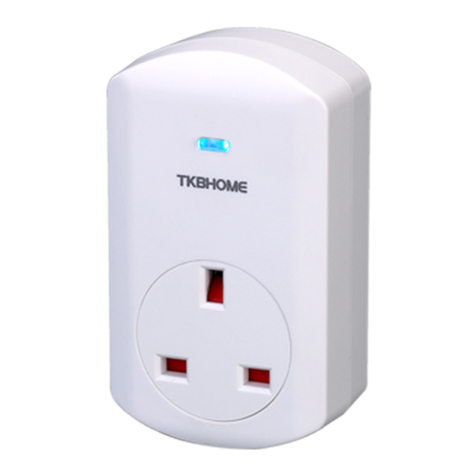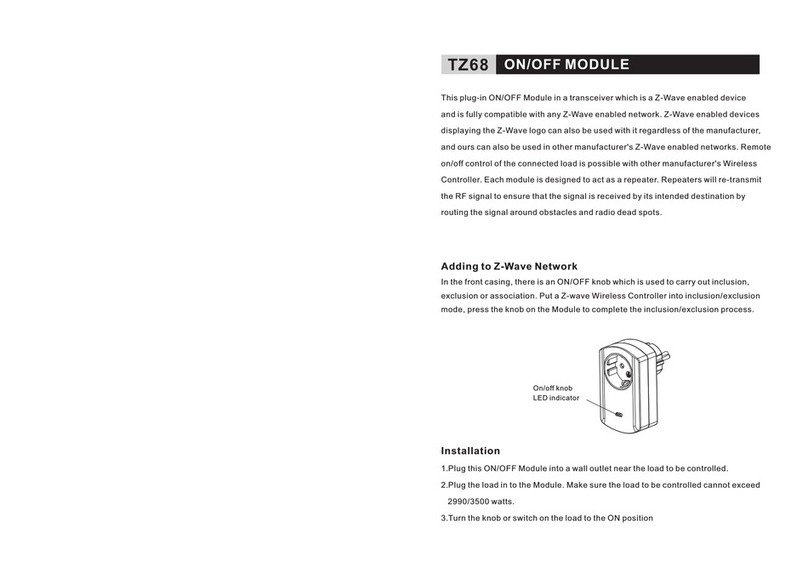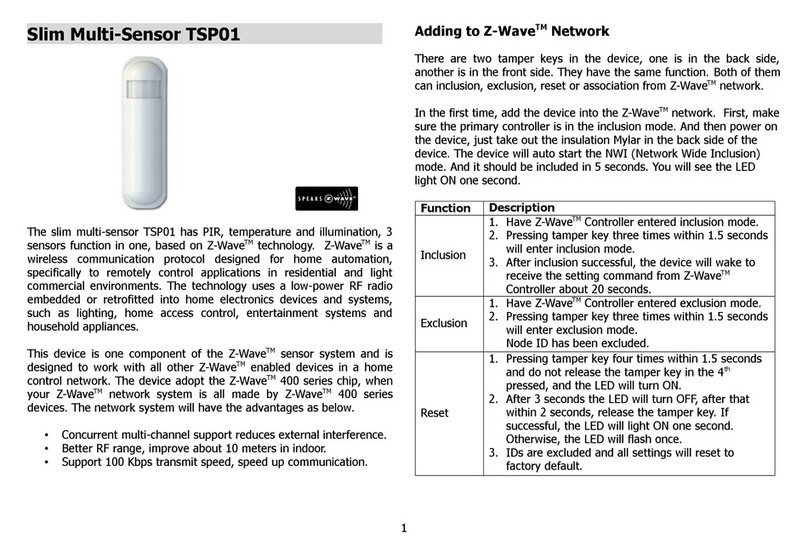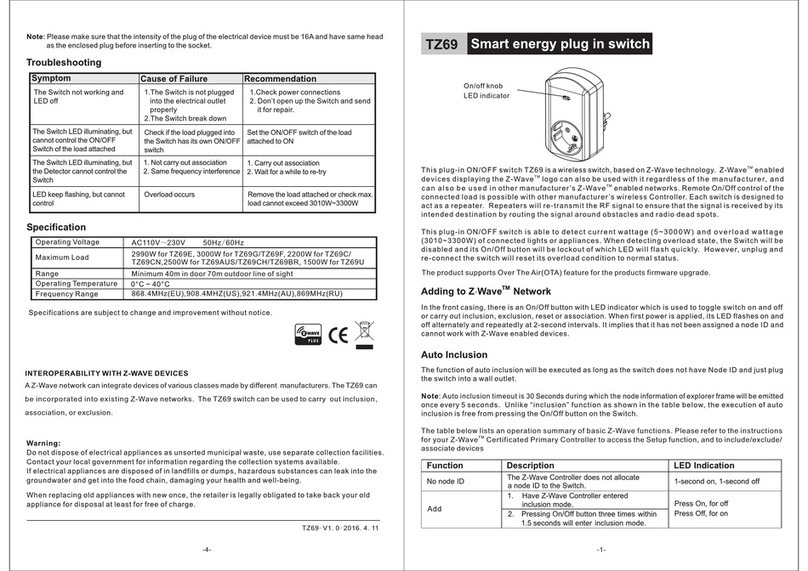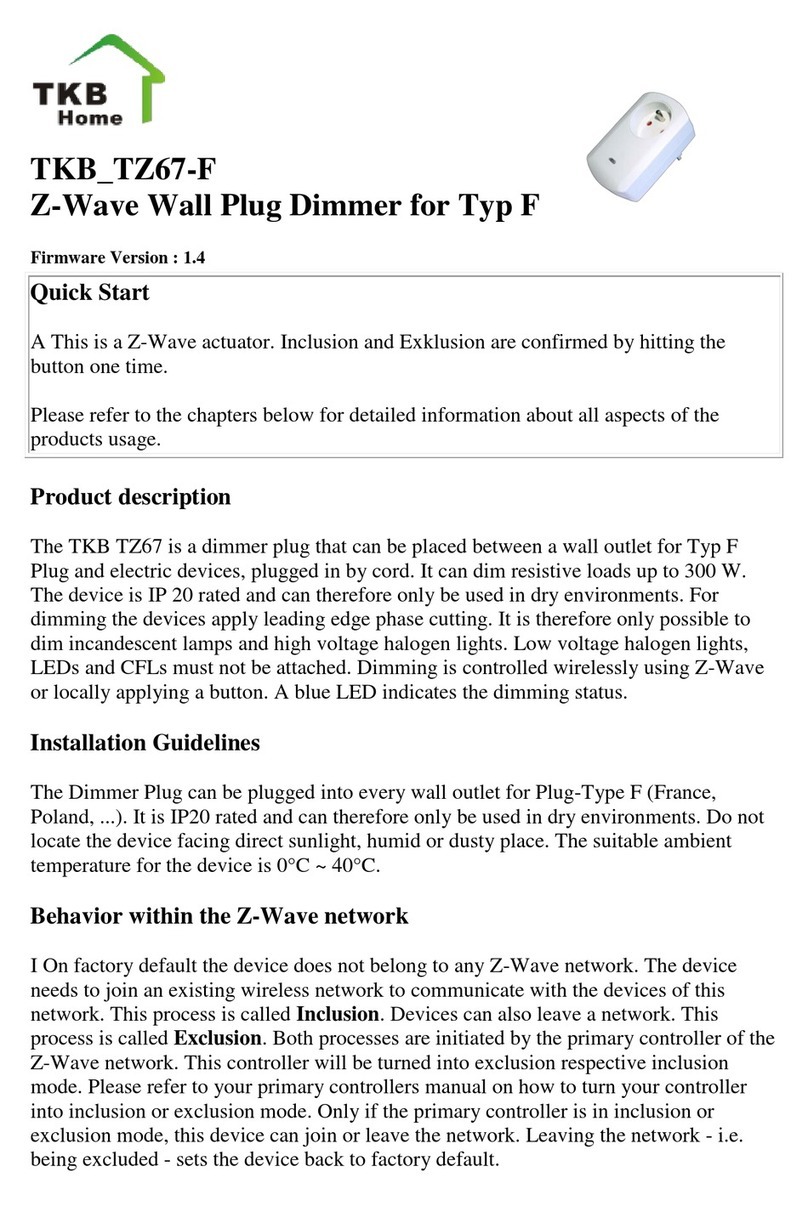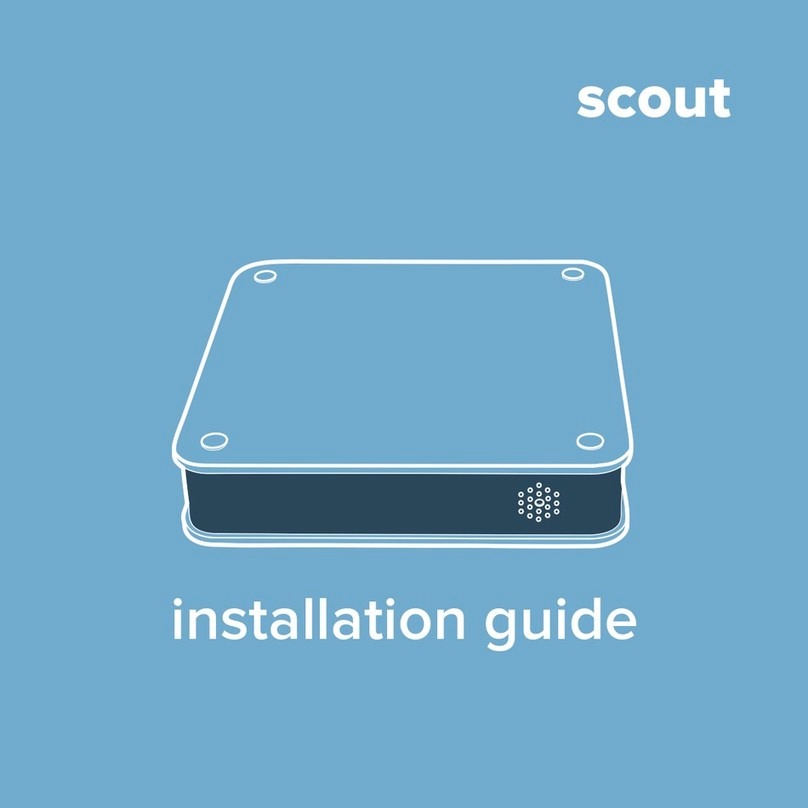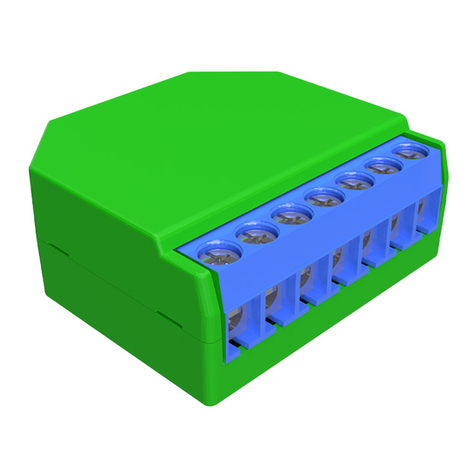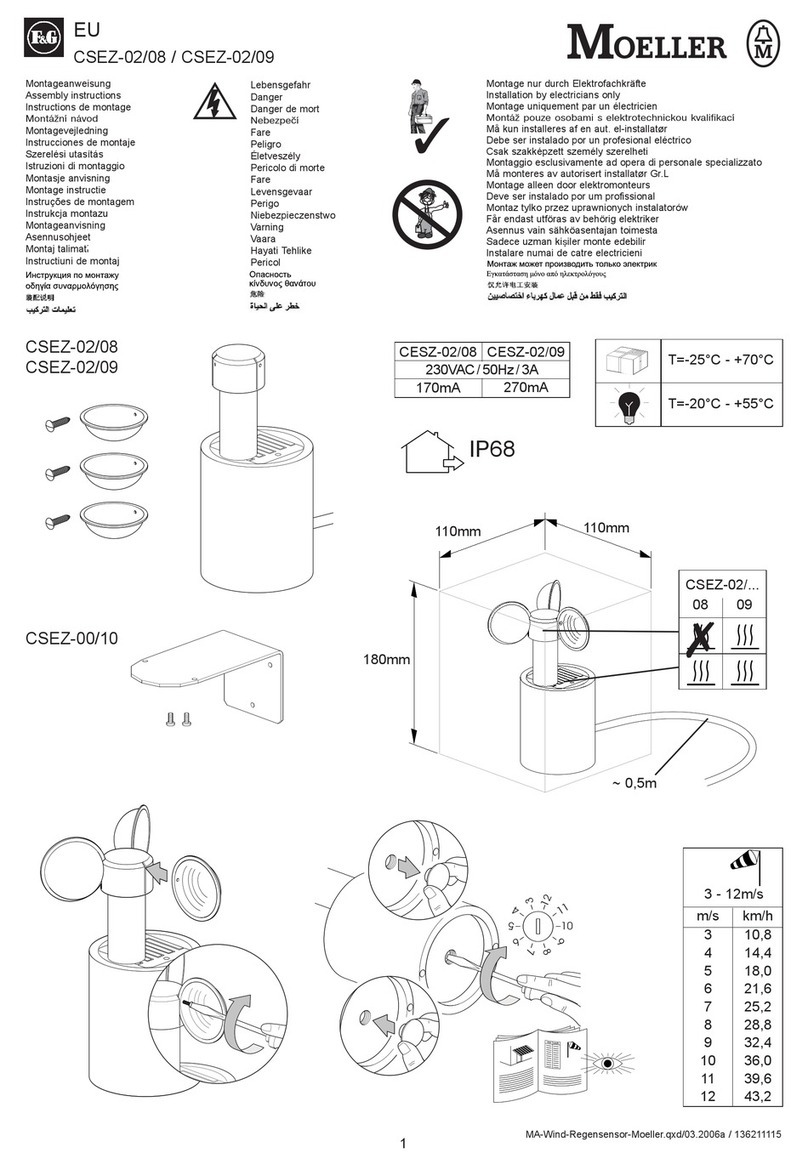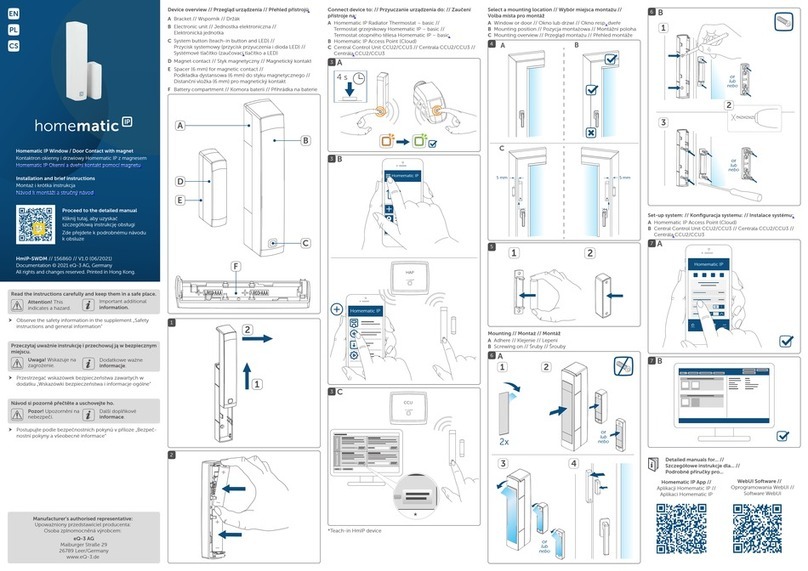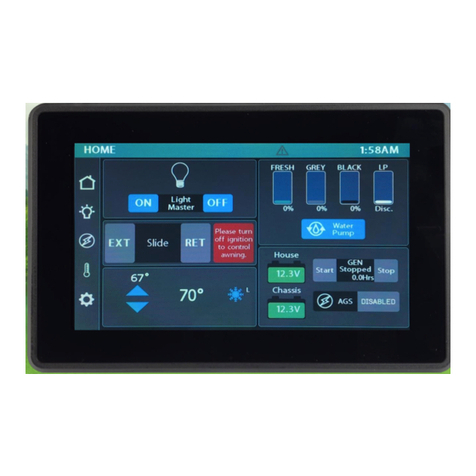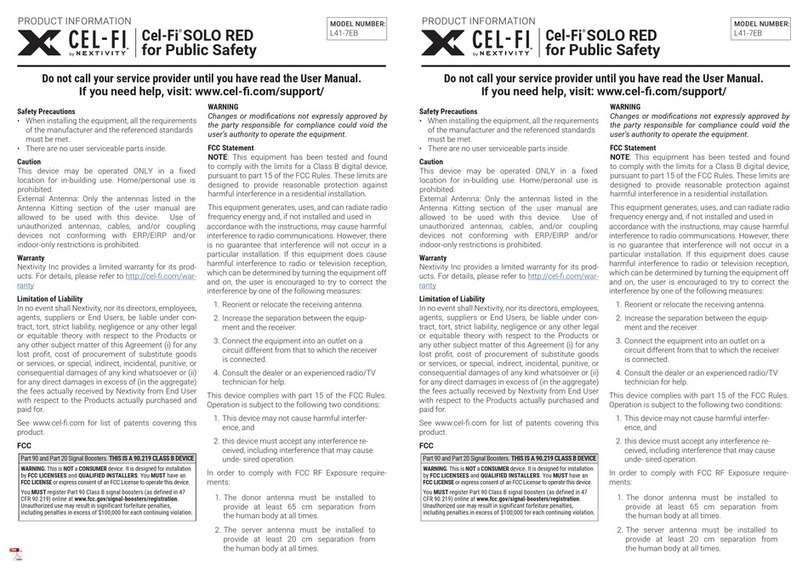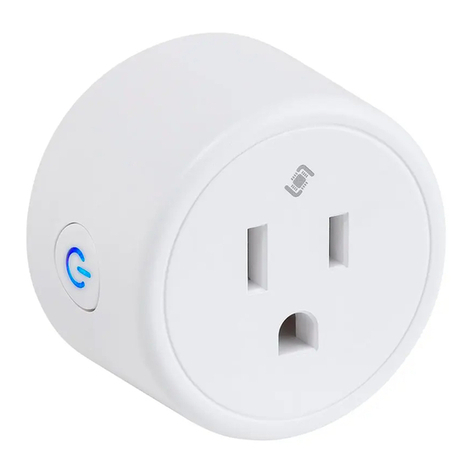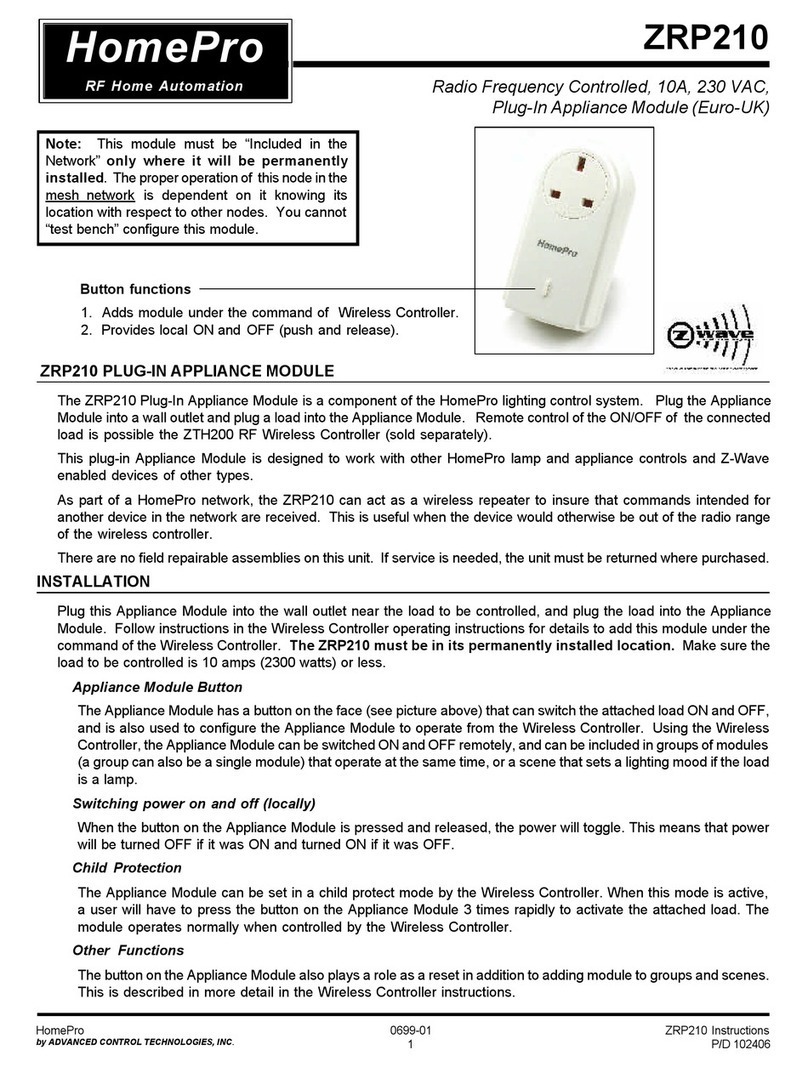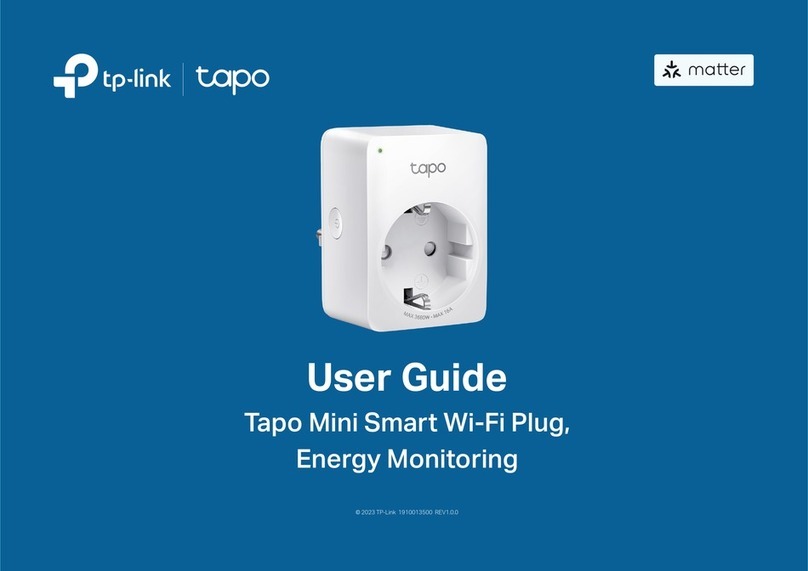TKB Home TKBETZ67-G User manual

TKB Home
Z-Wave Wall Plug Dimmer for Type F
SKU: TKBETZ67-G
Quickstart
This is a Light Dimmer for Europe. To run this device please connect it to your mains power supply.
Inclusion and Exclusion are confirmed by hitting the button one time.
What is Z-Wave?
Z-Wave is the international wireless protocol for communication in the Smart Home. This device is suited for use in the region mentioned in the Quickstart
section.
Z-Wave ensures a reliable communication by reconfirming every message ( two-way communication)
and every mains powered node can act as a repeater for other nodes (meshed network) in case the
receiver is not in direct wireless range of the transmitter.
This device and every other certified Z-Wave device can be used together with any other certified Z-
Wave device regardless of brand and origin as long as both are suited for the same frequency
range.
If a device supports secure communication it will communicate with other devices secure as long as
this device provides the same or a higher level of security. Otherwise it will automatically turn into a
lower level of security to maintain backward compatibility.
For more information about Z-Wave technology, devices, white papers etc. please refer to www.z-wave.info.
Product Description
The TKB TZ67 is a dimmer plug that can be placed between a wall outlet for Typ G Plug and electric devices, plugged in by cord. It can dim resistive loads
up to 300 W. The device is IP 20 rated and can therefore only be used in dry environments. For dimming the devices apply leading edge phase cutting. It is
therefore only possible to dim incandescent lamps and high voltage halogen lights. Low voltage halogen lights, LEDs and CFLs must not be attached.
Dimming is controlled wirelessly using Z-Wave or locally applying a button. A blue LED indicates the dimming status.
Prepare for Installation / Reset
Please read the user manual before installing the product.
In order to include (add) a Z-Wave device to a network it must be in factory default state. Please make sure to reset the device into factory default. You
can do this by performing an Exclusion operation as described below in the manual. Every Z-Wave controller is able to perform this operation however it is
recommended to use the primary controller of the previous network to make sure the very device is excluded properly from this network.
Safety Warning for Mains Powered Devices
ATTENTION: only authorized technicians under consideration of the country-specific installation guidelines/norms may do works with mains power. Prior to
the assembly of the product, the voltage network has to be switched off and ensured against re-switching.
Installation
The Dimmer Plug can be plugged into every wall outlet for Plug-Type F. It is IP20 rated and can therefore only be used in dry environments. Do not locate
the device facing direct sunlight, humid or dusty place. The suitable ambient temperature for the device is 0°C ... 40°C.
Inclusion/Exclusion
On factory default the device does not belong to any Z-Wave network. The device needs to be added to an existing wireless network to communicate
with the devices of this network. This process is called Inclusion.
Devices can also be removed from a network. This process is called Exclusion. Both processes are initiated by the primary controller of the Z-Wave
network. This controller is turned into exclusion respective inclusion mode. Inclusion and Exclusion is then performed doing a special manual action right

on the device.
Inclusion
hit the button on the device.
Exclusion
hit the button on the device.
Product Usage
The device is able to dim electric load up to 300 W. Short press of the button will toggle. This means that the power will be turned on if it was off and turned
off when it was on. When switching the lamp on or off the light will dim for about 2 seconds until the final level is reached.
The the button is constantly pressed the light will be dimmed. The dimming function will also toggle. Constantly pressing the the button will either dim up or
dim down the light until it reaches the final level.
Quick trouble shooting
Here are a few hints for network installation if things dont work as expected.
1. Make sure a device is in factory reset state before including. In doubt exclude before include.
2. If inclusion still fails, check if both devices use the same frequency.
3. Remove all dead devices from associations. Otherwise you will see severe delays.
4. Never use sleeping battery devices without a central controller.
5. Dont poll FLIRS devices.
6. Make sure to have enough mains powered device to benefit from the meshing
Association - one device controls an other device
Z-Wave devices control other Z-Wave devices. The relationship between one device controlling another device is called association. In order to control a
different device, the controlling device needs to maintain a list of devices that will receive controlling commands. These lists are called association groups
and they are always related to certain events (e.g. button pressed, sensor triggers, ...). In case the event happens all devices stored in the respective
association group will receive the same wireless command wireless command, typically a 'Basic Set' Command.
Association Groups:
Group Number Maximum Nodes Description
15 Lifeline
Configuration Parameters
Z-Wave products are supposed to work out of the box after inclusion, however certain configuration can adapt the function better to user needs or unlock
further enhanced features.
IMPORTANT: Controllers may only allow configuring signed values. In order to set values in the range 128 ... 255 the value sent in the application shall be
the desired value minus 256. For example: To set a parameter to 200 it may be needed to set a value of 200 minus 256 = minus 56. In case of a two byte
value the same logic applies: Values greater than 32768 may needed to be given as negative values too.
Parameter 1: Indicator Light
Change the state of indicator lite
Size: 1 Byte, Default Value: 1
Setting Description
0The LED is On, if the device is on
1The LED is On, if the device is Off
Parameter 2: Memory function
Save the last status or not.
Size: 1 Byte, Default Value: 1
Setting Description
0Do not save the last status
1Save the last status
Technical Data

Dimensions 0.0600000x0.0750000x0.1020000 mm
Weight 131 gr
EAN 6959174467628
Voltage 230 V
Load 300 W
Device Type Light Dimmer Switch
Generic Device Class Multilevel Switch
Specific Device Class Routing Multilevel Switch
Firmware Version 03.0c
Z-Wave Version 02.40
Certification ID ZC10-16010003
Z-Wave Product Id 0x0118.0x0202.0x0611
Supported Command Classes
Basic
Switch Multilevel
Switch All
Configuration
Manufacturer Specific
Powerlevel
Protection
Node Naming
Version
Explanation of Z-Wave specific terms
Controller — is a Z-Wave device with capabilities to manage the network. Controllers are typically Gateways,Remote Controls or battery operated
wall controllers.
Slave — is a Z-Wave device without capabilities to manage the network. Slaves can be sensors, actuators and even remote controls.
Primary Controller — is the central organizer of the network. It must be a controller. There can be only one primary controller in a Z-Wave network.
Inclusion — is the process of adding new Z-Wave devices into a network.
Exclusion — is the process of removing Z-Wave devices from the network.
Association — is a control relationship between a controlling device and a controlled device.
Wakeup Notification — is a special wireless message issued by a Z-Wave device to announces that is able to communicate.
Node Information Frame — is a special wireless message issued by a Z-Wave device to announce its capabilities and functions.
(c) 2019 Z-Wave Europe GmbH, Antonstr. 3, 09337 Hohenstein-Ernstthal, Germany, All rights reserved, www.zwave.eu. The template is maintained by Z-Wave
Europe GmbH. The product content is maintained by Z-Wave Europe GmbH , Supportteam, sup[email protected]u. Last update of the product data: 2018-05-30
10:50:46
Table of contents
Other TKB Home Home Automation manuals
Popular Home Automation manuals by other brands
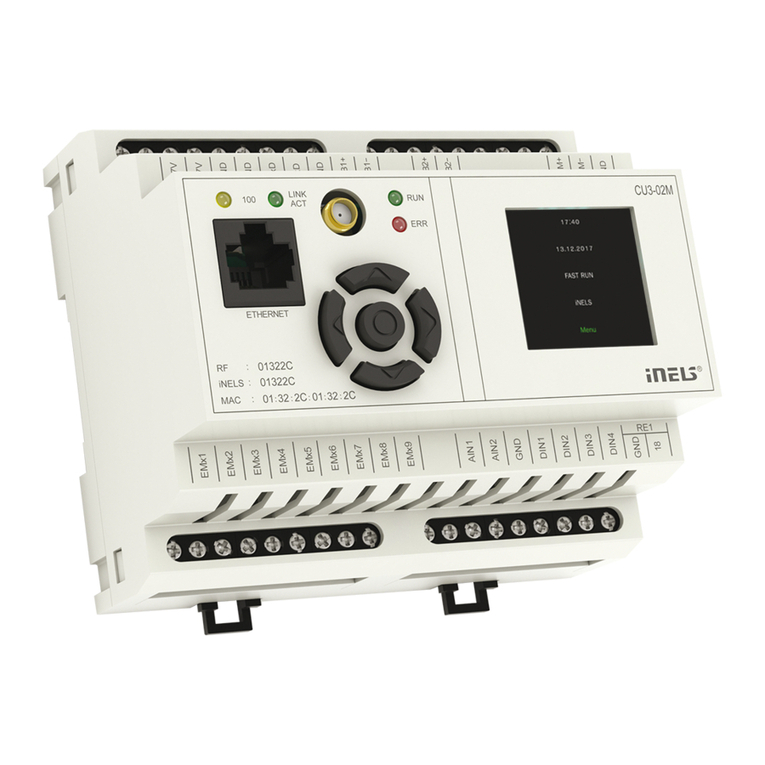
iNels
iNels CU3-01M user manual
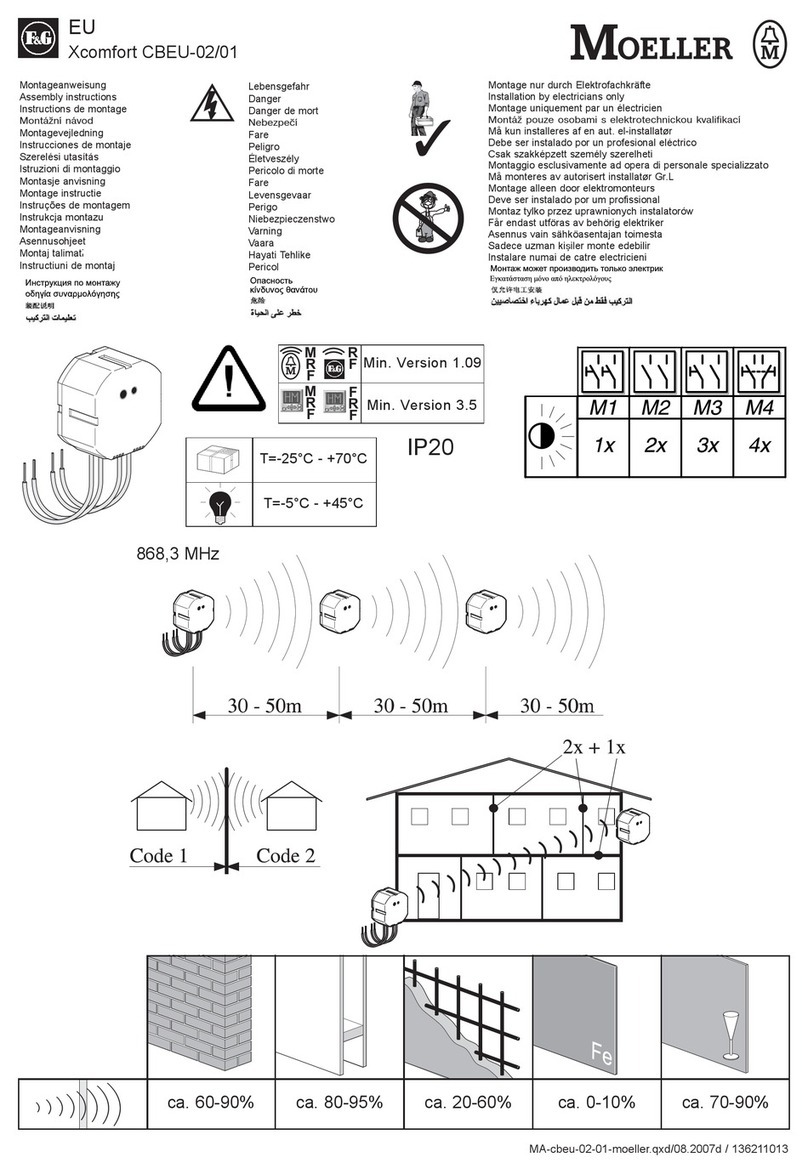
F&G
F&G Moeller Xcomfort CBEU-02/01 Assembly instructions
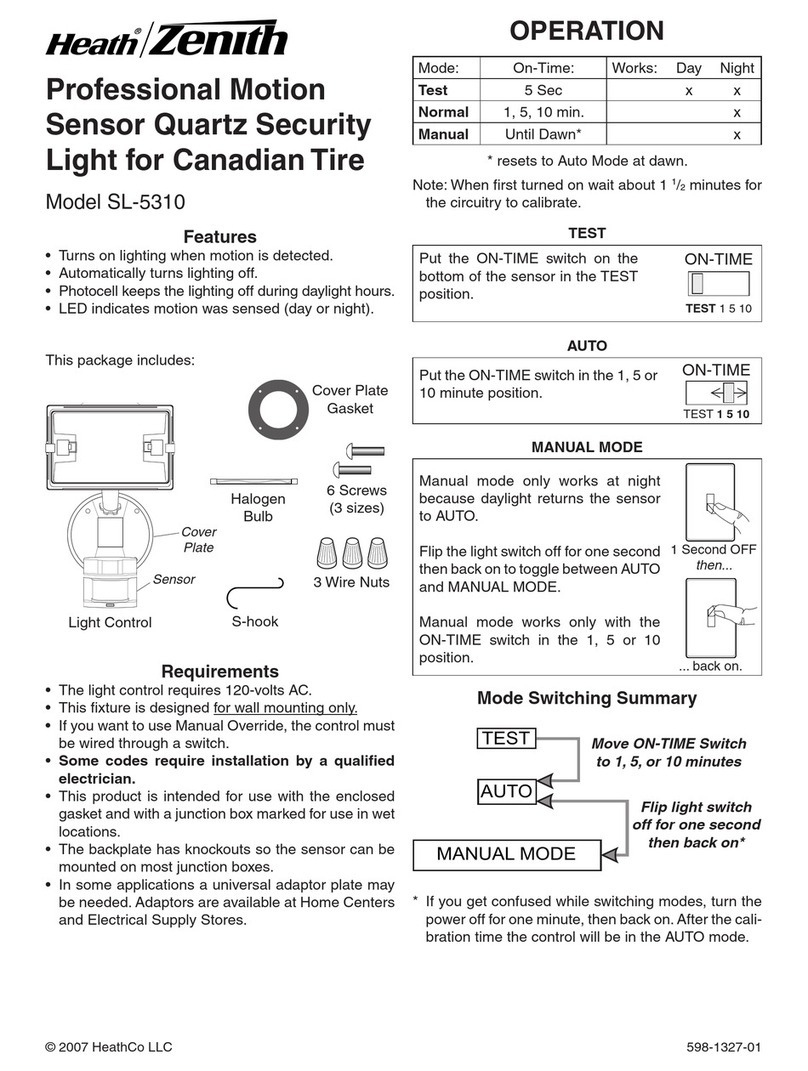
Heath Zenith
Heath Zenith SL-5310 owner's manual
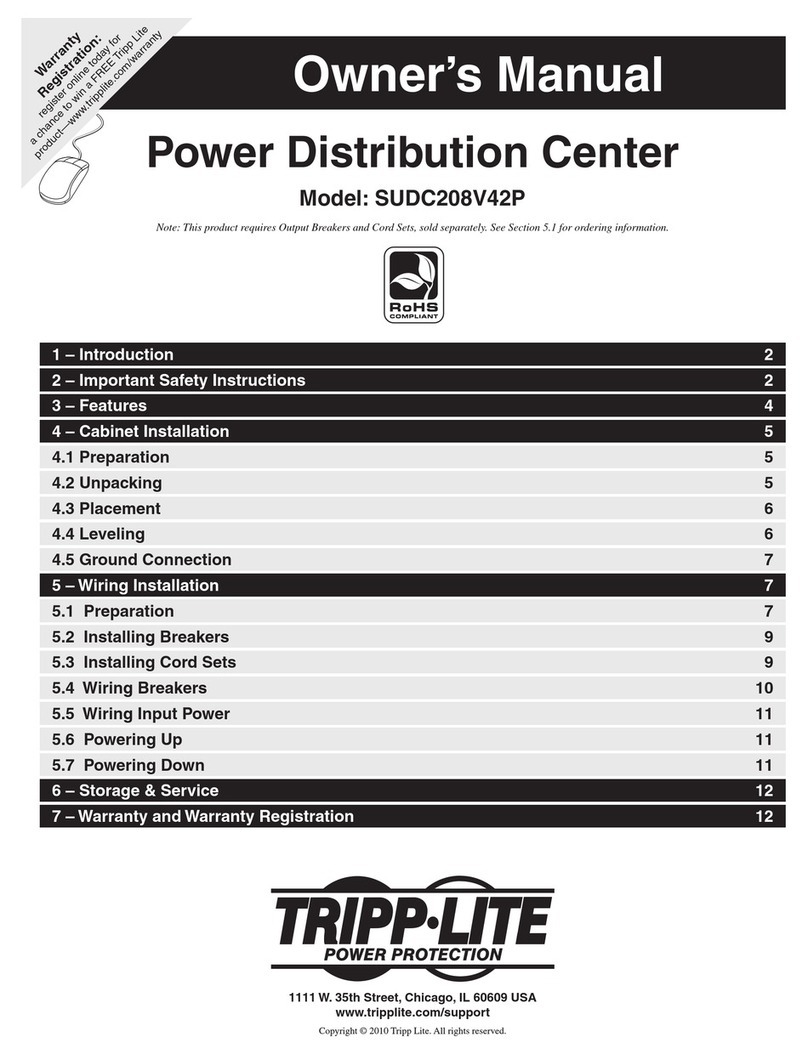
Tripp Lite
Tripp Lite SUDC208V42P owner's manual
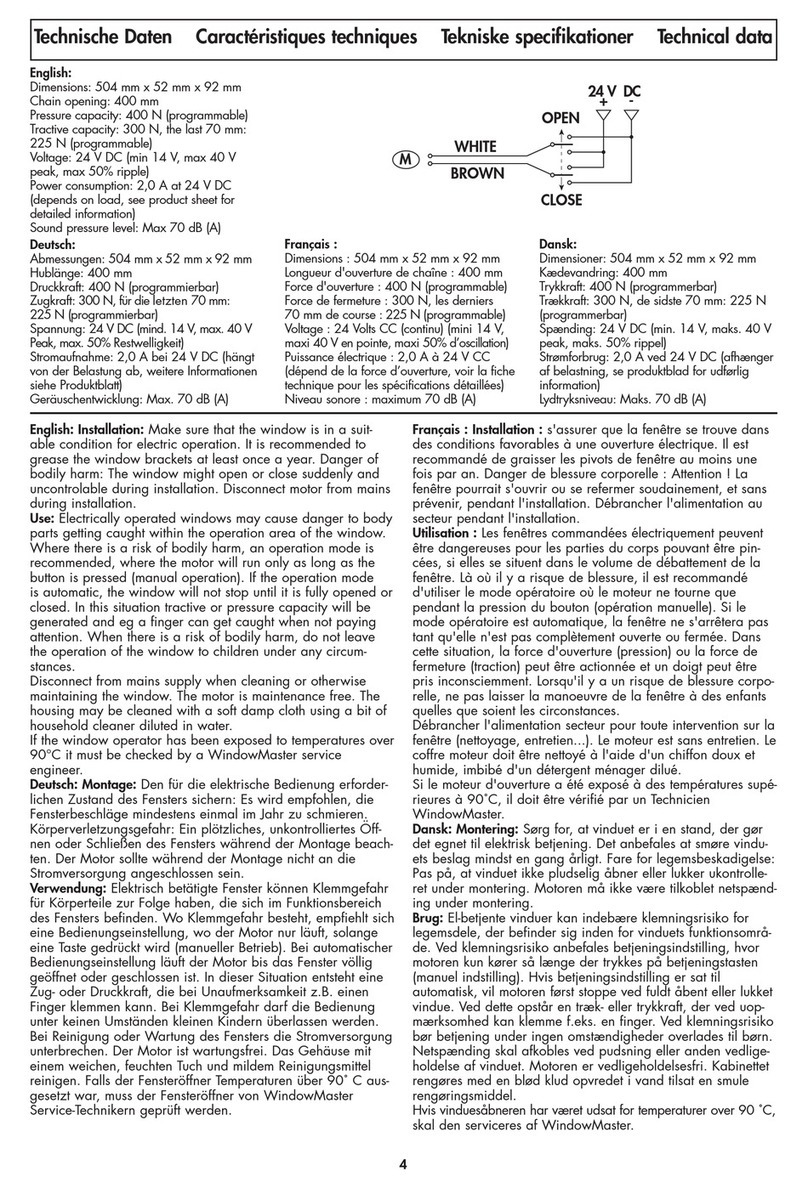
WindowMaster
WindowMaster WMU 120 installation instructions
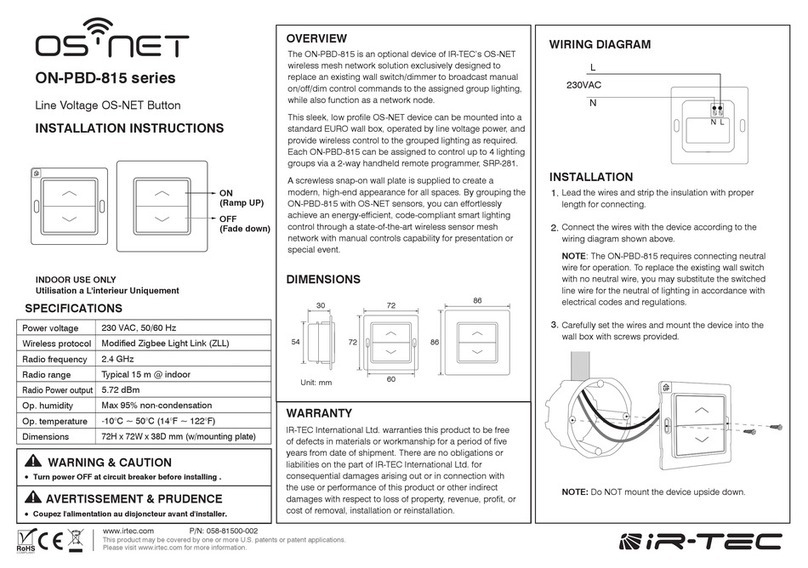
IR-Tec
IR-Tec Os-Net ON-PBD-815 Series installation instructions
